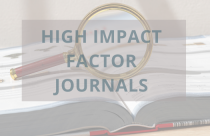Journal Cited Half-Life: What Does It Mean and Why Is It Important?

Many journals brag about publishing up-to-date, cutting edge research and most researchers want to publish their work in such journals. Journal cited half-life, also known as aggregate cited half-life, is a measure sometimes used to evaluate the current interest in a journal. However, journal cited half-life is not a reliable measure of this and should be used with care.
How Old are Cited Articles?
A journal may be cited hundreds or thousands of times per year but the articles cited will vary in age. Some will be only a few months old, having been published in the same calendar year as the citation; other articles may have been published decades before. Journal cited half-life counts all the journal citations during one calendar year and calculates the median article publication date—half of the cited articles were published before this time, half were published afterwards. The number is expressed as years before the calendar year of interest, e.g., for the year 2012, a cited half-life of 5 years means that half of all the cited articles were published before January 1, 2008 and half were published afterwards. The phrase “half-life” is an awful, misleading descriptor of the concept but is obviously thought to be catchier than “cited journal median publication year.”
Significance of Journal Cited Half-life
Many factors impact journal cited half-life. Journals that have only recently begun publishing articles will generally have shorter half-lives than older journals. Journals with a recent blockbuster article will be weighted towards a recent year. Finally, journals publishing Rapid Communications will generally have more recent half-lives than those that publish full articles. The following table reports the journal cited half-life results of the publications for the year 2011 (as obtained from ResearchGate).

Implications of Journal Cited Half-life
As expected, Chemical Communications has a short cited half-life of about 5 years. The complete research will be described later in journals like JACS, which has a longer cited half-life of 7 years. Chemical Reviews has the longest cited half-life since it publishes valuable, well-researched articles that are by definition not cutting edge. However, note that JACS publishes communications as well as full papers. A communication in JACS might get just as much attention as one in Chemical Communications, but the cited half-life doesn’t reflect this, since the larger number of full papers in JACS skews its cited half-life towards a higher number.
How to Use Cited Half-life?
I think cited half-life is most useful to librarians trying to decide which journals to stock. I don’t think it has much use to a researcher, except as a quick check on an unfamiliar journal to confirm that its cited half-life is in the expected range for a journal of rapid communications, full papers, or scholarly reviews.









